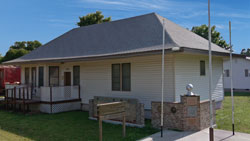History
Jones Historical Society Museum
145 1st Street
At the Corner of 1st & Boston
Jones, Oklahoma
Jones, Oklahoma
Jones is a town in Oklahoma County, in the Oklahoma City metro area. Covering 13.662 square miles, present Jones is surrounded on three sides by Oklahoma City and by the town of Harrah to the east-southeast and the town of Choctaw to the south-southeast.
First Platted
Luther F. Aldrich platted the townsite on April 22, 1898. Aldrich, a friend and business associate of Oklahoma City’s three-time mayor Charles G. “Gristmill” Jones, named the town after him, and Jones later named his eldest son Luther, indicating his esteem for Aldrich.
Railroad
C. G. Jones, an industrialist, and railroad promoter were instrumental in bringing the railroad through a town know then as Glaze, Oklahoma. C.G. Jones played a big part in Oklahoma Statehood, and was also a State Reprehensive, just to name a few of his accomplishments.
Visit the Jones Oklahoma Historical Society Museum, located at 145 First and Boston Street.
Jones is situated just south of the place that Washington Irving described as “The Ringing of Horses” (site listed in the National Register of Historic Places, NR 71001081) in his book A Tour on the Prairies (1835).
Early Years
In the early years, the economic base was agriculture. The Charles G. Jones Farmstead is also listed in the National Register of Historic Places (NR 01000658).
Jones was strategically located to take maximum advantage of the railroad for shipping, for commuting to work, and for traveling to Tulsa or Oklahoma City for shopping and entertainment. Successful promotion attracted new residents to the area, and circa 1902 Edwin G. Bedford platted an addition to the town.
Incorporation
Jones incorporated on January 4, 1909. In 1910 the U.S. Census counted 163 inhabitants.
In the early 1940s, during World War II, Midwest Air Depot (later Tinker Air Force Base) opened twenty miles south of Jones and became a prime employment center. After the war ended, trains no longer stopped at Jones, commuters traveled by automobile to the air depot or Oklahoma City, finding it convenient to shop in that city before returning home from work.
Growth
The town has grown steadily during the second half of the twentieth century from 794 residents in 1960 to 2,270 in 1980, and 2,517 in 2000. The relatively sudden increase in population indicated that the town had become a “bedroom” community.
By 2000 approximately half of the employed residents commuted at least thirty minutes to jobs in larger towns. Jones has a mayor-council form of government, and its public schools enrolled 1,048 in grades kindergarten through twelve in 2000.
Visit the Jones Historical Society

